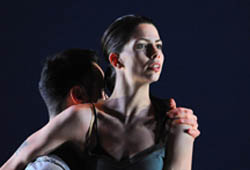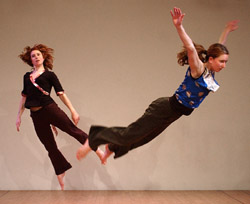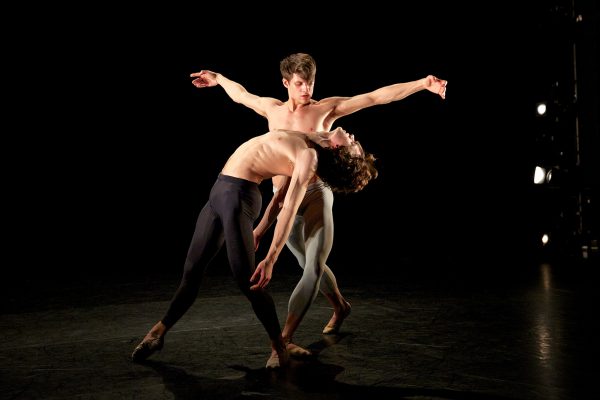Marie Chouinard’s “The Golden Mean (Live)” is titled after the mathematical ratio used since ancient times to create pleasing proportions in art and architecture. The Parthenon was apparently designed using this formula, and it’s evident in the painting of the Mona Lisa. The Golden Mean also occurs naturally, in the spiral of a snail shell, for example. It’s also been called the “divine proportion,” as Chouinard notes in the program. Yet this eighty-minute, one-act work is more about human excess and extremes than about divinity and ideals. Which is not a criticism: that excess and those extremes are fascinating.
The work, which premiered during the Vancouver 2010 Cultural Olympiad as part of the DanceHouse series at the Playhouse Theatre, is a wonderful oddity, performed by twelve tousle-haired blondes (all the dancers wear the same short wig). Liz Vandal has costumed them in transparent, flesh-coloured pants, and they’re bare-chested, the women with small cones fitted over their breasts, the men with tufts of fur covering their nipples. The look is primal, though wouldn’t be out of place in an exotic dance act. Faces are gently distorted through the use of a barely visible half-mask that smoothes the cheeks and forehead into a block, allowing the mobile, expressive mouth to stand out.
Surprisingly, the mouth is a key choreographic motif: it hangs softly open or stretches into a grimace; it emits cries and wails, belly laughs, squeaks and very loud (and too shrill) screams. A man pulls his partner up off the floor by grabbing hold of her teeth. A duet is performed with the two dancers’ wide-open mouths clamped together. Later, in a seated, tangled duet, the toes of one are firmly held in the mouth of the other.
This focus on the mouth gives the dancers a strange physicality. Their new and different nature is established right at the start when two female dancers slowly emerge like newborns from under separate golden cocoons. Yet “The Golden Mean (Live)” is situated very much in the ordinary present world through the use of contemporary political and social references. The first instance of this comes right near the top, when one dancer, and then the whole group, strap on large cardboard masks of Stephen Harper’s face with his trademark tight smile. They become a chorus line of Stephens, stepping and strutting about, at times almost ape-like when they dip down and drop their arms so the knuckles hit the floor. At the end of this sequence, the tallest and the shortest dancer do a brief duet — the small “Stephen” wrapping her legs with swing-style oomph around the tall one — a bit of nonsense that left the audience chuckling.
Clearly, Chouinard’s sense of fun gets an airing in this piece. But the work also had a sombre side, evident in longtime Chouinard interpreter Carol Prieur’s fearless and accomplished solo. Here, Louis Dufort’s precise minimalist score gives way to a quiet, ethereal choir. Prieur, now in a short white sarong, has white cones covering her breasts, and her long brown hair hangs loose. Her dance is full of non sequiturs: a hand flaps, a leg kicks, a knee thrusts upwards. “Have you seen my son?” she asks. “Do you know what love is?” She veers from aggression to despair, like some crack-addicted street person in Vancouver’s notorious downtown eastside (just a short walk away from the theatre). For most of this harrowing solo, the other dancers sit and watch, each wearing another oversize mask, this time printed with the face of a white-haired senior citizen, some men, some women, all smiling beatifically.
At this point, the dancers-as-seniors are huddled together on the ramp, a long white runway that extends into the audience. From my row five seat, I watched the close-up on the masks that was streamed onto the five onstage screens; the action on the runway is captured in real time by a camera, ensuring I didn’t have to crane my neck to view it. Other audience members were behind the ramp or looking down on it from the balcony. Yet others had an unusual onstage viewpoint: the wings are left open, with a row of seats placed stage left and right for a handful of ticket-buyers.
The ramp breaks into the auditorium in a startling way, and the onstage audience reminds us of our role as spectators, all part of Chouinard’s disruptive and bold staging, which brings a layer of subtext about the nature of theatricality into the work. We also see the stagehands doing their stealth walk as they go about their business in the background, and the dancers move standing lights into place. Those lamps are tall and grey, with large round heads; when they’re bent over the dancers they look like giant androids angling for a closer look. (I was reminded of the late Lola MacLaughlin’s exploration of similar themes to do with the constructed experience of theatre and art in “Provincial Essays”, which also had the dancers manipulating large standing lights.)
“The Golden Mean (Live)”, often bathed in the golden glow of Alexis Bowles’ lighting design, is beautifully performed, though the movement itself is not particularly beautiful: it is, instead, interesting, peculiar, full of stretch one moment, and collapsed and floppy the next. The ensembles are raucous; the duets are grappling, unsettled. It’s as if these beings are unable to communicate: they are too engrossed in their own intense physical sensations, they don’t “get” other people. This is suggested by the duet that is a game of laughter and tears: when she’s crying, he’s laughing, and vice versa, throughout its duration. At the end, she does a wonderful little dance, crying all the while she leaps, does the splits, takes a quick yoga pose, skips, tap dances, and finishes in a retiré, arms in fifth. Then she kicks him and her tears turn to laughter — and he cries. Chouinard choreographs emotions here as much as she does movement, although the feelings are like a party trick, put on for the occasion in stark black and white, and not subtle or golden at all.
This mysterious and thought-provoking work will doubtless go on to tour like so many others by the renowned Montréal artist. Currently, she has several past works booked internationally, and her “24 Preludes by Chopin” is in The National Ballet of Canada’s repertoire. Chouinard is a phenomenon and “The Golden Mean (Live)” is, too, in its unusual way.
Tagged: Ballet, Contemporary, Performance, BC




